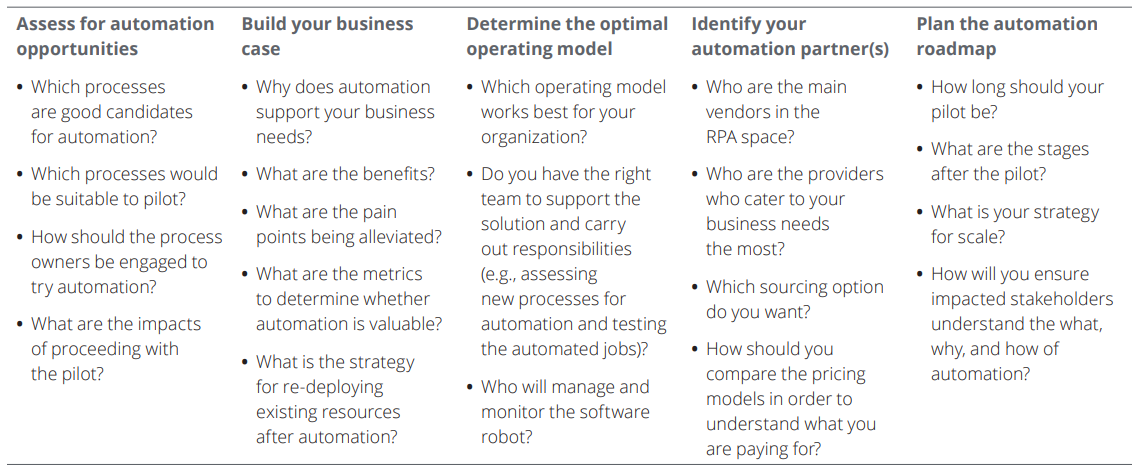Robotic Process Automation (RPA) is one of the best solutions to implement on your digital transformation journey. But it's one thing to understand the benefits of RPA and a whole other thing to implement RPA to your business process without experience. Here we discuss a step-by-step process for implementing RPA.
RPA Implementation Challenges
To successfully implement RPA, it's important to make a list of various challenges and prepare a strategy to overcome these challenges. Here are some of the key challenges businesses face during RPA implementation:
- Misguided expectations of RPA
- Using the wrong tools tools
- Working with an inexperienced RPA partner
- Inability to calculate ROI
- Identifying the wrong processes for RPA implementation
- Technical and operational issues
- Stopping short of full, end-to-end process automation
- Lack of support from leadership
- Shortage of skilled team
- Preparing workforce for shift in workload
Considerations for RPA Implementation
Apart from addressing the above challenges, there are many other considerations to be made, such as cost, license, maintenance support, ROI, and so on. Above all one has to decide whether they should work with an RPA vendor or implement RPA using in-house resources.
The below table details topics to think about before the implementation process starts.
How to Develop RPA Tool: RPA Implementation Process
1. List out Processes To Automate
Not all business processes are suitable for RPA. Businesses should develop a strategy to pick the right processes and then prioritize them based on metrics like complexity and ROI. Think about what automating these processes will look like, its purpose, business context, and how it fits into future business operations or overall automation journey.
2. Perform Feasibility Assessment
Perform a feasibility assessment for each process to evaluate to what extent the process can be automated. This is a two-step process, where process examination and technical feasibility are carried out. The operation user, an SME (Subject Matter Expert), and an RPA expert should execute this assessment.
Learn how to perform feasibility assessment here.
3. Readjust
Based on the feasibility assessment report, identify the processes that are not structured, standardized, optimized, recorded, or not executed as planned. In this stage, try to reoptimize and restructure the process.
4. Gather User Stories
A user story describes the features of an application to be built from an end-user perspective. It explains user requirements in detail. It's also important to get a detailed description of each process to be automated. Based on this data, develop a process definition document with defined RPA workflows for the development team.
5. Start Development Process
In this stage, based on the RPA workflows generated the development process begins. The developers create automated scripts and program code using RPA tools like UiPath, Blue Prism, and so on. Each RPA tool has unique capabilities so businesses should be very specific in choosing an appropriate tool based on their needs.
6. Test RPA Process
Perform thorough testing to study performance in all possible scenarios and bugs when the process is executed. Send potential performance issues and bugs to the development team to fix.
7. Reconfirm and Deploy
Once the initial tests and errors are corrected by the development teams, confirm the results are perfect and deploy the complete RPA solution.
















